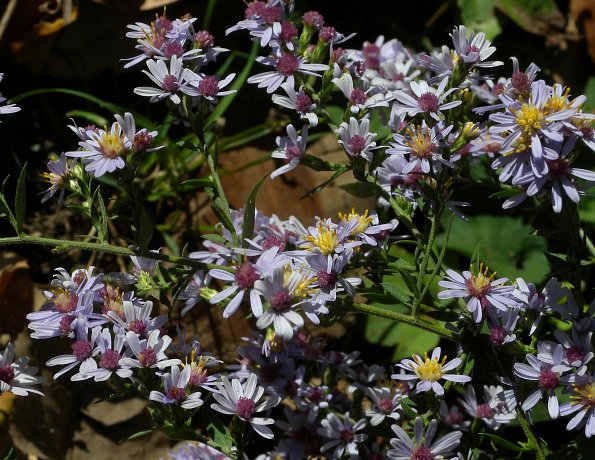
Alternate leaves occur along these stems that are 1-4" long and ½-3" across (becoming smaller in size as they ascend the stems); they are cordate below, becoming cordate-ovate to lanceolate above. The margins of these alternate leaves are coarsely serrated below, becoming serrated to slightly crenate-serrate above. The upper surfaces of these leaves are moderate green and sparsely short-pubescent to densely short-pubescent, while their lower surfaces are light green and moderately to densely short-pubescent or pubescent throughout; this pubescence is not restricted to the major veins. When these leaves are exposed to bright sunlight, they may become yellowish green. Leaf texture tends to be stiff and rough. The petioles of alternate leaves are ½-2" long and their margins are more or less winged; they are moderately to densely short-pubescent. Sometimes small secondary leaves appear in the axils of these leaves. Each leafy stem terminates in a panicle of flowerheads about ½-2' long and about one-half as much across. In addition to the central stalk of the panicle, there are several ascending lateral branches along which most of the flowerheads occur on short peduncles (less than ½" long). The central stalk, branches and peduncles are light green to purple, terete, and evenly short-pubescent to pubescent.
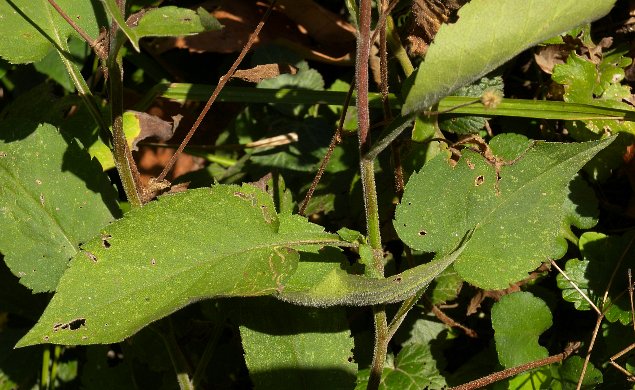
Each flowerhead is about ½" across, consisting of 10-15 ray florets that surround 10-15 congested disk florets. The petaloid rays of these flowerheads are usually lavender or light violet (less often white) and linear-oblong in shape. The short-tubular disk florets are initially cream-colored to yellow, but they later become reddish purple. Each disk floret has 5 short lobes that are erect. Around the base of each flowerhead, the scale-like phyllaries (floral bracts) are arranged in several overlapping series; these phyllaries are appressed together, or nearly so. Individual phyllaries are 4-6 mm. in length, linear-lanceolate in shape, and light green, except for diamond-shaped patches of dark green near their apices. Leafy bracts occur along central stalk and lateral branches of the panicle that are up to 1" long and elliptic to linear-oblong in shape; they are slightly toothed to entire (smooth) along their margins. The blooming period occurs from late summer into autumn for 1-3 months. Afterwards, the florets are replaced by achenes with small tufts of white hair. The achenes are 2-3 mm. long, oblongoid-oblanceoloid in shape, slightly ribbed, and light to medium brown (sometimes with reddish or purplish tints). They are distributed by the wind. The root system is fibrous and short-rhizomatous. On older plants, a small woody caudex may develop. Clonal offsets are often produced from the rhizomes.
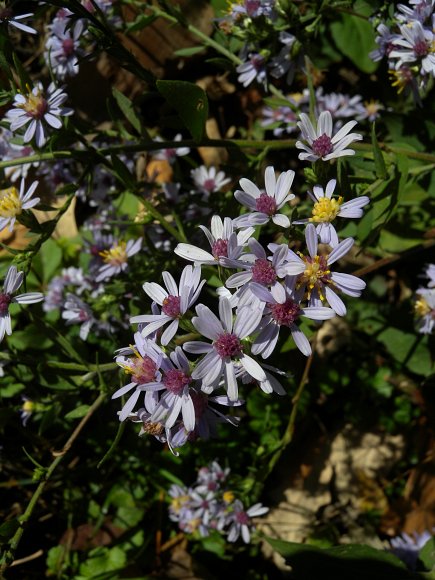
Cultivation: The preference is partial sun, mesic to dry-mesic conditions, and soil containing loam, clay-loam, or some rocky material. This wildflower is usually easy to cultivate. The foliage may become discolored with age; lower leaves may wither away in response to hot dry conditions. There is a tendency for the flowering stems to sprawl across the ground during the autumn.
Range & Habitat: The native Drummond's Aster is common in central and northern Illinois, while in the southern section of the state it is occasional to locally common (see Distribution Map). Habitats include upland woodlands, rocky woodlands, woodland openings, woodland borders, areas along woodland paths, disturbed open woodlands, upland savannas, thinly wooded bluffs, powerline clearances through wooded areas, thickets, partially shaded riverbanks, burnt-over vacant lots, edges of yards, and partially shaded areas along roadsides. Drummond's Aster can be found in both high quality natural areas and degraded sites. Occasional wildfires are beneficial when they reduce excessive shade from overhead canopy trees. The woodlands where this aster occurs are dominated by various deciduous trees, especially oaks (Quercus spp.).
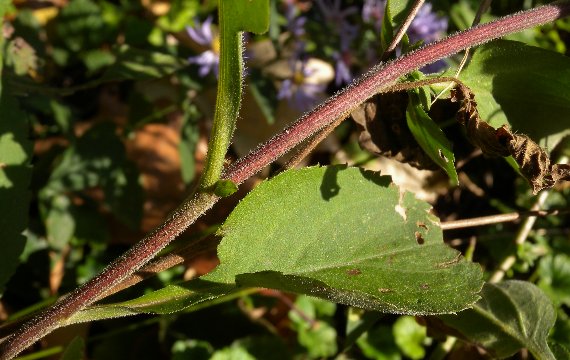
Faunal Associations: The flowers are cross-pollinated by honeybees, bumblebees, Halictid bees (including green metallic bees), Andrenid bees, miscellaneous wasps, Syrphid flies, Tachinid flies, Muscid flies, butterflies, skippers, moths, and other insects. Both nectar and pollen are available as floral awards to such visitors. The following bees are oligolectic visitors (pollinator specialists) of aster flowers: Andrena asteris, Andrena asteroides, Andrena hirticincta, Andrena nubecula, Andrena solidaginis, and Colletes simulans armata. Some of these oligoleges also visit goldenrod flowers. Other insects that are associated with Drummond's Aster and other asters (Symphyotrichum spp.) include leaf beetles, larvae of fruit flies and leaf-mining flies, plant bugs, lace bugs, stink bugs, aphids, leafhoppers, walkingsticks, caterpillars of butterflies, and caterpillars of many moths. These insects feed destructively on the leaves, flowers, developing seeds, stems, roots, or plant juices (see the Insect Table and Moth Table for more information about these species). In general, asters are less important to vertebrate animals. However, such upland gamebirds as the Ruffed Grouse and Wild Turkey feed occasionally on the foliage and seeds; such mammals as deer, rabbits, groundhogs, and livestock also feed on the foliage.
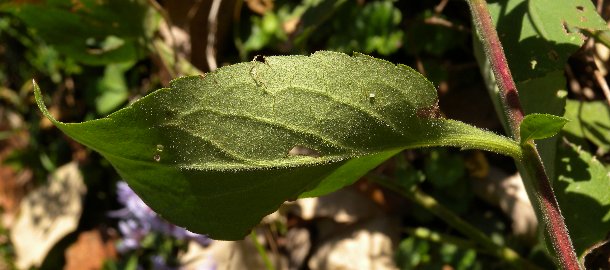
Photographic Location: Edge of a wooded area at Crystal Lake Park in Urbana, Illinois.
Comments: Drummond's Aster (Symphyotrichum drummondii) is part of a complex of similar species involving Arrow-Leaved Aster (Symphyotrichum sagittifolium), Heart-leaved Aster (Symphyotrichum cordifolium), and White Arrowleaf Aster (Symphyotrichum urophyllum). There has been a history of taxonomic instability involving the interrelationships between these 4 species. Some of these species are considered varieties of each other by some taxonomists, or they have been merged with other species within this complex. Drummond's Aster can be distinguished from other species (or varieties) in this complex by the evenly distributed pubescence along its stems and by the evenly distributed pubescence on the lower sides of its leaves. The abundance and conspicuousness of this pubescence can vary across different populations of plants in Illinois. Drummond's Aster also differs from Heart-leaved Aster by its winged petioles; this is a trait that it shares with the remaining species of this complex. Relatively recently, all of these species have been assigned to the Symphyotrichum genus; Drummond's Aster was referred to previously as Aster drummondii. While the individual flowerheads are relatively small, the inflorescence of this aster is often quite large and showy during the autumn.